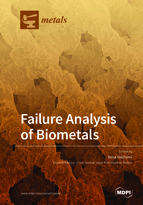Failure Analysis of Biometals
A special issue of Metals (ISSN 2075-4701).
Deadline for manuscript submissions: closed (15 January 2020) | Viewed by 61758
Special Issue Editor
Interests: mechanical behaviour of materials; additive manufacturing; tribology and tribocorrosion; biometals; materials testing and characterisation
Special Issues, Collections and Topics in MDPI journals
Special Issue Information
Dear Colleagues,
Metallic biomaterials (biometals) are widely used for the manufacture of medical implants, ranging from load-bearing orthopaedic prostheses to dental and cardiovascular implants, because of their favourable combination of properties including high strength, fracture toughness, biocompatibility, wear and corrosion resistance. Additionally, they can be fabricated using well-established techniques (such as casting and forging), and recently, additive manufacturing to produce complex and customised implants. Examples of metals and metal alloys that are used for the fabrication of implants include: Ti-based alloys (e.g., Ti6Al4V and Ti6Al7Nb), Co-based alloys (e.g., CoCrMo and CoNi), austenitic stainless steels (e.g., SS316L), Zr-Nb alloys, Ni-Ti Alloys, Mg alloys, porous tantalum foams, and precious metals and alloys.
Due to the significant consequences of implant material failure/degradation, in terms of both personal and financial burden, failure analysis of biometals (in vivo, in vitro and retrieval) has been always of paramount importance in order to understand the failure mechanisms and implement suitable solutions with the aim to improve the longevity of implants in the body.
This Special Issue aims to present the latest developments and findings in the area of biometals failure. The scope includes (but is not limited to): New/advanced biometals, microstructural evaluation, mechanical properties, failure/degradation analysis, fracture, fatigue, wear, fretting wear, fretting corrosion, corrosion, in vitro and in vivo assessments, explant analysis, implant retrieval studies, biocompatibility assessments, porous biometals, surface modifications, simulations, and modelling.
Research articles, review articles, as well as communications, are invited.
Dr. Reza H Oskouei
Guest Editor
Manuscript Submission Information
Manuscripts should be submitted online at www.mdpi.com by registering and logging in to this website. Once you are registered, click here to go to the submission form. Manuscripts can be submitted until the deadline. All submissions that pass pre-check are peer-reviewed. Accepted papers will be published continuously in the journal (as soon as accepted) and will be listed together on the special issue website. Research articles, review articles as well as short communications are invited. For planned papers, a title and short abstract (about 100 words) can be sent to the Editorial Office for announcement on this website.
Submitted manuscripts should not have been published previously, nor be under consideration for publication elsewhere (except conference proceedings papers). All manuscripts are thoroughly refereed through a single-blind peer-review process. A guide for authors and other relevant information for submission of manuscripts is available on the Instructions for Authors page. Metals is an international peer-reviewed open access monthly journal published by MDPI.
Please visit the Instructions for Authors page before submitting a manuscript. The Article Processing Charge (APC) for publication in this open access journal is 2600 CHF (Swiss Francs). Submitted papers should be well formatted and use good English. Authors may use MDPI's English editing service prior to publication or during author revisions.
Keywords
- Biometals
- Failure Analysis
- In-vitro and In-vivo Assessments
- Retrieval Studies
- Microstructure
- Fatigue and Fracture
- Fretting Wear
- Corrosion, Fretting Corrosion
- Biotribology
- Biocompatibility
- Simulation and Modelling






